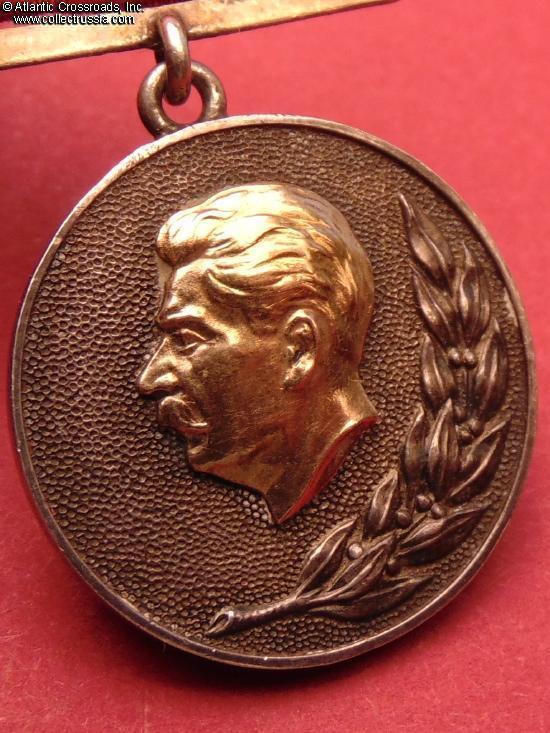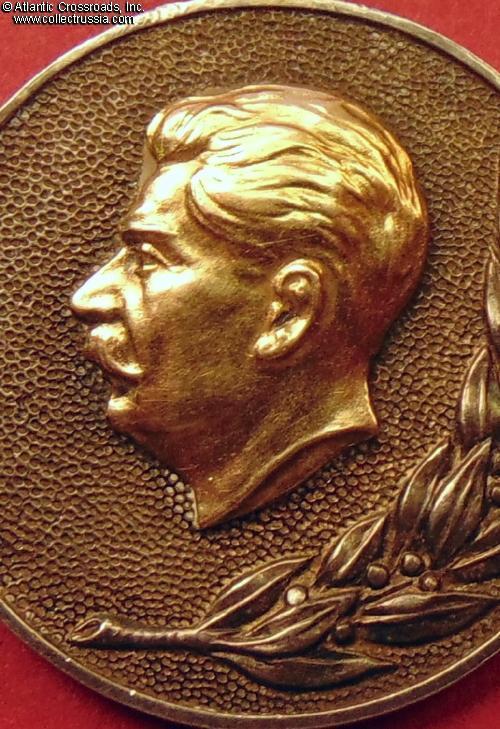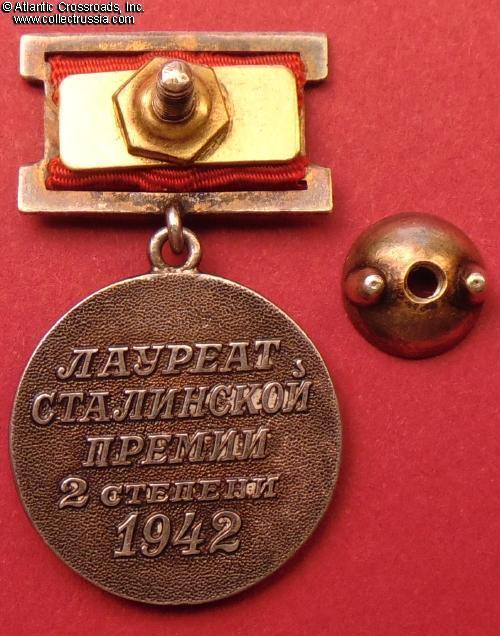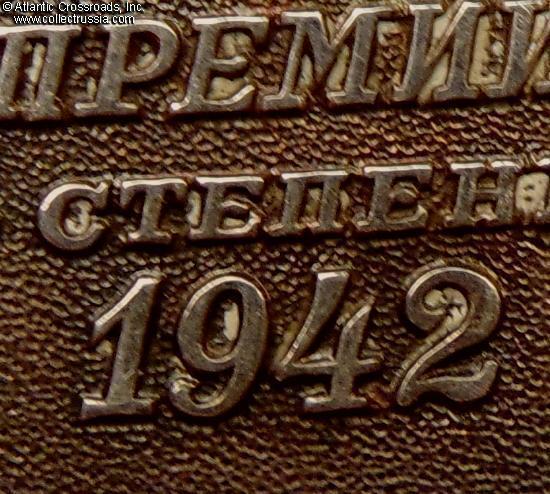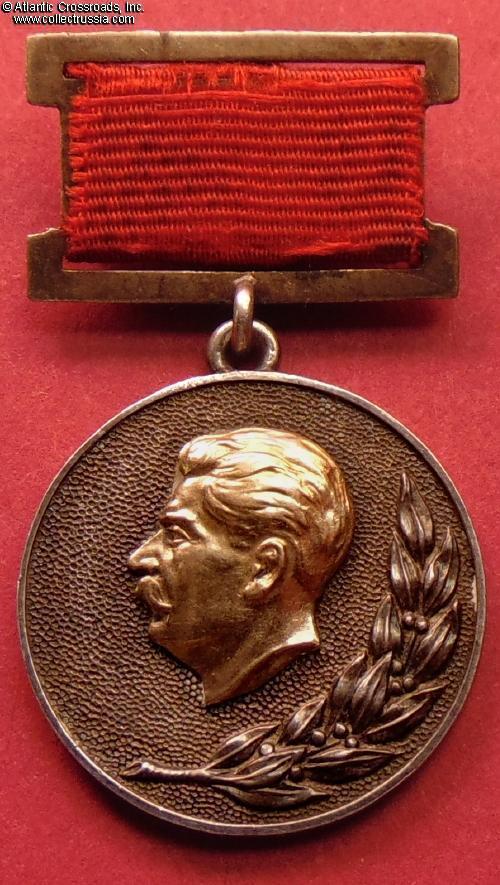
Stalin Prize Medal, 2nd class, 1942 issue.
The medallion is in silver and solid 14 K gold (Stalin's bust); measures 26.1 mm wide; weighs 11.0 g not including the suspension device; total weight with suspension and screw plate is 17.6 g. The suspension device is in silver gilt, measures 24.7 mm in width.
The medal is in outstanding, excellent condition, absolutely superb for a Patriotic War issue. The bas-relief shows almost no wear, and its details are exceptionally well- preserved, almost pristine. The wreath as well as the stippling on the background of the obverse are perfect and crisp. The raised edg
The medallion is in silver and solid 14 K gold (Stalin's bust); measures 26.1 mm wide; weighs 11.0 g not including the suspension device; total weight with suspension and screw plate is 17.6 g. The suspension device is in silver gilt, measures 24.7 mm in width.
The medal is in outstanding, excellent condition, absolutely superb for a Patriotic War issue. The bas-relief shows almost no wear, and its details are exceptionally well- preserved, almost pristine. The wreath as well as the stippling on the background of the obverse are perfect and crisp. The raised edge has a few tiny dings and scrapes mostly under the eyelet, all of them nearly unnoticeable. The reverse is likewise practically pristine, with perfect crisp lettering and almost untouched stippling. Just like the obverse, there are only a few tiny dings at the edge of the reverse, none of them detractive or easily noticeable to the unaided eye. The silver shows beautiful even patina throughout.
The medal comes on original suspension device, complete with the rectangular back plate, hexagon retaining nut and screw nut. The suspension is beautifully preserved and exhibits nice patina, while the original gilt finish is clearly visible on all of its parts. The screw post measures over 8 mm long from the rectangular back plate, has not been reduced. The screw nut fits perfectly. The ribbon is old, probably original to the medal; although it shows wear to the top edge, it is still sound, clean and very attractive. Its ends are sewn together, as often observed on original ribbons of the period. To summarize, condition of this medal is superb, literally impossible to upgrade - especially for a WW2 issue.
The 1942 Stalin Prize Medal of any class is extremely rare, much more so than the post-war issues. When Stalin Prize was conceived in 1939 to celebrate Stalin's 60th birthday, it was supposed to be a purely monetary reward paid for by the proceeds from published works of Stalin. The first series of awards were bestowed in 1941 for achievements of all the previous years starting from 1935, whereas in the following years they were given only for the results attained in the year preceding the award (e.g. the 1942 prize was for achievements of 1941 etc.) In the last two years of WW2, 1944-45, there was a hiatus when no Stalin prizes were awarded at all.
The medal of a Stalin Prize winner came up only after the war, in late 1945, and starting from 1946 it was retroactively issued to the Prize winners of the previous years. This retroactive awarding explains why each medal has only the date without the serial number: the early recipients already had their award documents, and adding the serial numbers to the existing award documentation would've created a bureaucratic nightmare. The medals however do differ by the year of award which is shown in raised numerals on the reverse, a part of the die unique for each year of issue. Here lies an important distinction making some of the medals far more scarce than others.
The main reason for that is that areas of recognition for the Stalin Prize gradually expanded from year to year, as did the number of awards issued yearly in each category. According to Anatoly Kutsenko's Cavaliers in 1941, the first year of its issue, there were 389 people awarded Stalin Prizes of all three classes combined. By comparison, the number increased to 710 recipients in the year of 1948, 1605 in 1950, and 2691 in 1951. The difference in the number of medals of early vs late issue is clearly immense.
It is also noteworthy that during the Khurschev's "de- Stalinization", the Stalin Prize was replaced with a newly coined State Prize. The surviving winners of the Stalin Prize - at least those still in the public eye - were expected to exchange the "politically incorrect" medals with Stalin's image for the State Prize Medals of the corresponding classes. The returned original awards were then invariably melted down. Therefore, the availability of the Stalin Prize Medals on today's collectors market is far less than the number of issues alone would suggest.
Considering the "de-Stalinization" factor and given the
small number of the early Stalin Prize issues in comparison
to the post-war ones, it is clear why any 1942 Stalin Prize
Medal is extremely rare. Based on Soviet records recently
published on the Internet, slightly over 60 Second Class
prizes were awarded in 1942 in wide variety of fields from
precise science and technological improvements to arts and
literature. Because some of the monetary rewards were given
to a group of people who contributed to the same project
each of whom received a portion of the money, the number of
laureates - and hence the number of medals issued - was
larger than the number of actual prizes awarded. A review
of the published list of laureates for 1942 shows that
there
were 133 people in total who received the Second Class of
the Stalin Prize that year. This leads to conclusion
that
no more than 133 of the Second Class Medals of 1942 were
ever struck at the mint (the actual number must be even
smaller accounting for the almost inevitable attrition in
the number of living laureates during the war years.) To
put
things into perspective, there were fewer issues of the
1942
Stalin Prize Medal, 2nd cl. than either Order of Ushakov
2nd
cl. or Order of Suvorov 1st cl.
$7,500.00 Add to cart

